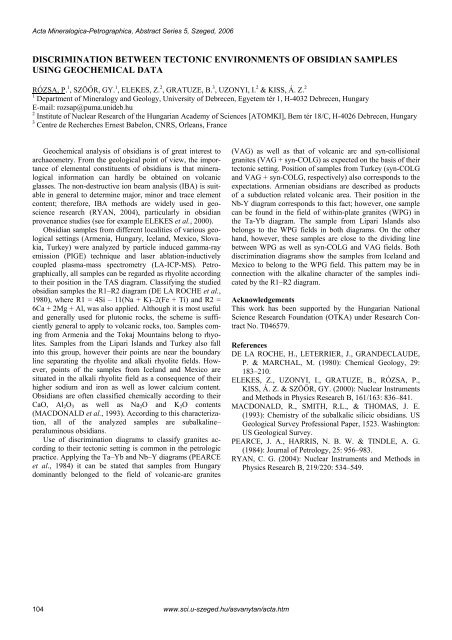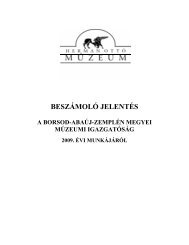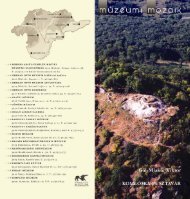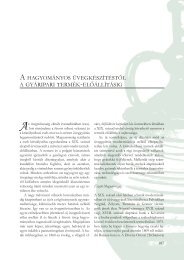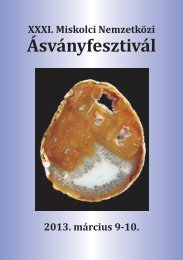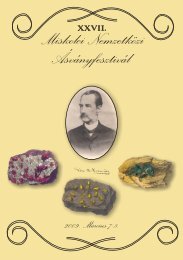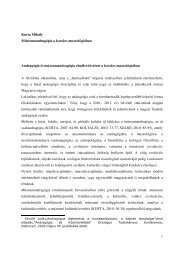Acta Mineralogica-Petrographica, Abstract Series 5, Szeged, 2006DISCRIM<strong>IN</strong>ATION BETWEEN TECTONIC ENVIRONMENTS OF OBSIDIAN SAMPLESUS<strong>IN</strong>G GEOCHEMICAL DATARÓZSA, P. 1 , SZÖŐR, GY. 1 , ELEKES, Z. 2 , GRATUZE, B. 3 , UZONYI, I. 2 & KISS, Á. Z. 21 Department of Mineralogy and Geology, University of Debrecen, Egyetem tér 1, H-4032 Debrecen, HungaryE-mail: rozsap@puma.unideb.hu2 Institute of Nuclear Research of the Hungarian Academy of Sciences [ATOMKI], Bem tér 18/C, H-4026 Debrecen, Hungary3 Centre de Recherches Ernest Babelon, CNRS, Orleans, FranceGeochemical analysis of obsidians is of great interest toarchaeometry. From the geological point of view, the importanceof elemental constituents of obsidians is that mineralogicalinformation can hardly be obtained on volcanicglasses. The non-destructive ion beam analysis (IBA) is suitablein general to determine major, minor and trace elementcontent; therefore, IBA methods are widely used in geoscienceresearch (RYAN, 2004), particularly in obsidianprovenance studies (see for example ELEKES et al., 2000).Obsidian samples from different localities of various geologicalsettings (Armenia, Hungary, Iceland, Mexico, Slovakia,Turkey) were analyzed by particle induced gamma-rayemission (PIGE) technique and laser ablation-inductivelycoupled plasma-mass spectrometry (LA-ICP-MS). Petrographically,all samples can be regarded as rhyolite accordingto their position in the TAS diagram. Classifying the studiedobsidian samples the R1–R2 diagram (DE LA ROCHE et al.,1980), where R1 = 4Si – 11(Na + K)–2(Fe + Ti) and R2 =6Ca + 2Mg + Al, was also applied. Although it is most usefuland generally used for plutonic rocks, the scheme is sufficientlygeneral to apply to volcanic rocks, too. Samples comingfrom Armenia and the Tokaj Mountains belong to rhyolites.Samples from the Lipari Islands and Turkey also fallinto this group, however their points are near the boundaryline separating the rhyolite and alkali rhyolite fields. However,points of the samples from Iceland and Mexico aresituated in the alkali rhyolite field as a consequence of theirhigher sodium and iron as well as lower calcium content.Obsidians are often classified chemically according to theirCaO, Al 2 O 3 as well as Na 2 O and K 2 O contents(MACDONALD et al., 1993). According to this characterization,all of the analyzed samples are subalkaline–peraluminous obsidians.Use of discrimination diagrams to classify granites accordingto their tectonic setting is common in the petrologicpractice. Applying the Ta–Yb and Nb–Y diagrams (PEARCEet al., 1984) it can be stated that samples from Hungarydominantly belonged to the field of volcanic-arc granites(VAG) as well as that of volcanic arc and syn-collisionalgranites (VAG + syn-COLG) as expected on the basis of theirtectonic setting. Position of samples from Turkey (syn-COLGand VAG + syn-COLG, respectively) also corresponds to theexpectations. Armenian obsidians are described as productsof a subduction related volcanic area. Their position in theNb-Y diagram corresponds to this fact; however, one samplecan be found in the field of within-plate granites (WPG) inthe Ta-Yb diagram. The sample from Lipari Islands alsobelongs to the WPG fields in both diagrams. On the otherhand, however, these samples are close to the dividing linebetween WPG as well as syn-COLG and VAG fields. Bothdiscrimination diagrams show the samples from Iceland andMexico to belong to the WPG field. This pattern may be inconnection with the alkaline character of the samples indicatedby the R1–R2 diagram.AcknowledgementsThis work has been supported by the Hungarian NationalScience Research Foundation (OTKA) under Research ContractNo. T046579.ReferencesDE LA ROCHE, H., LETERRIER, J., GRANDECLAUDE,P. & MARCHAL, M. (1980): Chemical Geology, 29:183–210.ELEKES, Z., UZONYI, I., GRATUZE, B., RÓZSA, P.,KISS, Á. Z. & SZÖŐR, GY. (2000): Nuclear Instrumentsand Methods in Physics Research B, 161/163: 836–841.MACDONALD, R., SMITH, R.L., & THOMAS, J. E.(1993): Chemistry of the subalkalic silicic obsidians. USGeological Survey Professional Paper, 1523. Washington:US Geological Survey.PEARCE, J. A., HARRIS, N. B. W. & T<strong>IN</strong>DLE, A. G.(1984): Journal of Petrology, 25: 956–983.RYAN, C. G. (2004): Nuclear Instruments and Methods inPhysics Research B, 219/220: 534–549.104www.sci.u-szeged.hu/asvanytan/acta.htm
Acta Mineralogica-Petrographica, Abstract Series 5, Szeged, 2006FERRUG<strong>IN</strong>OUS CONCENTRATIONS <strong>IN</strong> SANDSTONES NEAR DOBCZYCE (SILESIANUNIT, <strong>THE</strong> WESTERN POLISH <strong>CARPATHIANS</strong>) – PRELIM<strong>IN</strong>ARY RESULTSRZEPA, G., BAZARNIK, J., MUSZYŃSKI, M. & GAWEŁ, A.Department of Mineralogy, Petrography and Geochemistry, AGH University of Science and Technology, al. Mickiewicza 30,30-059 Krakow, PolandE-mail: grzesio@geolog.geol.agh.edu.plThe Istebna Beds that build the northern edge of theDobczyce retention reservoir on the Raba River near Brzączowice(ca. 30 km SE of Kraków) contain layers and bedsenriched in Fe compounds. They are rusty or yellowish, insome places become distinctly black. Within these iron-richhorizons, there occur characteristic, boxwork-like goethiteconcretions.Mineral composition of these ferruginous concentrationswith special attention to the boxwork-like concentrations,whose origin is still a matter of discussions, was investigatedusing transmitted light microscopy, X-ray diffractometry(XRD) and scanning electron microscopy (SEM-EDS). Theauthors also determined the contents of Fe and Mn; the figurescited below refer to the HCl-soluble Fe.Five types of Fe-rich concentrations that differ in theirmode of occurrence, Fe content and mineral compositionhave been distinguished on the basis of hand specimen featuresand preliminary mineralogical investigations:1) sandstones cemented (uniformly or non-uniformly) withFe oxyhydroxides (especially goethite), with coloursfrom yellow to almost black, containing dozen or so wt%Fe;2) goethite incrustations on the surfaces of sandstones,containing up to ca. 30 wt% Fe;3) boxwork-like concretions proper, composed almost ofpure goethite and containing up to 87 wt% Fe;4) sulphate-oxide concentrations, that are composed ofjarosite, goethite and detrital material and contain up to53 wt% Fe. Similar concentrations with secretion-likefeatures were described by GUCWA & WIESER (1976);5) phosphate-oxide aggregates that are mainly composed ofapatite, quartz, Fe and Mn oxides and contain up to 12wt% Fe.The main Fe mineral is usually cryptocrystalline goethite,but it may also form characteristic, fan-shaped aggregates ofelongated crystals, lining the walls of pores and fractures. Mnoxides are present in all types of ferruginous concentrations,either dispersed or in the form of incrustations, irregularconcentrations, veins and dendrites.On the basis of these preliminary investigations, the originof the Fe concentrations studied may be related to weatheringunder oxidizing conditions of primary, Fe-bearing minerals(silicates, sulphides and, possibly, carbonates) that musthave been present in surrounding rocks. Goethite, the mainFe component of these aggregates, can be formed in differentweathering environments characterized by a wide spectrumof physicochemical conditions (pH, Eh, foreign ions;CORNELL & SCHWERTMANN, 1996). Variations of theseparameters may have controlled the forms of occurrence andthe degree of crystallinity of goethite. Its presence in differentforms indicates several stages and/or mechanisms of weathering,various Fe sources, etc. The boxwork-like structuresresulted probably from precipitation of goethite from thesolutions that penetrated cracks in sandstones and progressivelyreplaced the primary rock with the iron oxyhydroxide(RUKH<strong>IN</strong>, 1953). In sulphate secretions goethite is probablya final product of co-existing jarosite transformation. Jarositecrystallizes from acid solutions with pH < 3 that are rich insulphates and Fe 3+ (DUTRIZAC & JAMBOR, 2000) and itspresence strongly implies weathering of sulphides.The investigations were supported by AGH-UST researchproject no. 11.11.140.158.ReferencesCORNELL, R. M. & SCHWERTMANN, U. (1996): Theiron oxides. Structures, properties, occurrences, characterizationand uses. Weinheim: VCH, 573 p.DUTRIZAC, J. E. & JAMBOR, J. L. (2000): In: ALPERS,C. N., JAMBOR, J. L. & NORDSTROM, D. K. (eds.)Sulfate minerals – crystallography, geochemistry and environmentalsignificance. Reviews in Mineralogy & Geochemistry,40: 405–452.GUCWA, I. & WIESER, T. (1976): Rocznik Polskiego TowarzystwaGeologicznego, 46: 197–215 (in Polish).RUKH<strong>IN</strong>, L. B. (1953): Osnovy litologii. Moskwa: Gostoptekhizdat,671 p. (in Russian).www.sci.u-szeged.hu/asvanytan/acta.htm 105
- Page 1:
MSCC33 rd MINERAL SCIENCES IN THE C
- Page 5 and 6:
Acta Mineralogica-Petrographica, Ab
- Page 7 and 8:
Acta Mineralogica-Petrographica, Ab
- Page 9 and 10:
Acta Mineralogica-Petrographica, Ab
- Page 11 and 12:
Acta Mineralogica-Petrographica, Ab
- Page 13 and 14:
Acta Mineralogica-Petrographica, Ab
- Page 15 and 16:
Acta Mineralogica-Petrographica, Ab
- Page 17 and 18:
Acta Mineralogica-Petrographica, Ab
- Page 19 and 20:
Acta Mineralogica-Petrographica, Ab
- Page 21 and 22:
Acta Mineralogica-Petrographica, Ab
- Page 23 and 24:
Acta Mineralogica-Petrographica, Ab
- Page 25 and 26:
Acta Mineralogica-Petrographica, Ab
- Page 27 and 28:
Acta Mineralogica-Petrographica, Ab
- Page 29 and 30:
Acta Mineralogica-Petrographica, Ab
- Page 31 and 32:
Acta Mineralogica-Petrographica, Ab
- Page 33 and 34:
Acta Mineralogica-Petrographica, Ab
- Page 35 and 36:
Acta Mineralogica-Petrographica, Ab
- Page 37 and 38:
Acta Mineralogica-Petrographica, Ab
- Page 39 and 40:
Acta Mineralogica-Petrographica, Ab
- Page 41 and 42:
Acta Mineralogica-Petrographica, Ab
- Page 43 and 44:
Acta Mineralogica-Petrographica, Ab
- Page 45 and 46:
Acta Mineralogica-Petrographica, Ab
- Page 47 and 48:
Acta Mineralogica-Petrographica, Ab
- Page 49 and 50:
Acta Mineralogica-Petrographica, Ab
- Page 51 and 52:
Acta Mineralogica-Petrographica, Ab
- Page 53 and 54: Acta Mineralogica-Petrographica, Ab
- Page 55 and 56: Acta Mineralogica-Petrographica, Ab
- Page 57 and 58: Acta Mineralogica-Petrographica, Ab
- Page 59 and 60: Acta Mineralogica-Petrographica, Ab
- Page 61 and 62: Acta Mineralogica-Petrographica, Ab
- Page 63 and 64: Acta Mineralogica-Petrographica, Ab
- Page 65 and 66: Acta Mineralogica-Petrographica, Ab
- Page 67 and 68: Acta Mineralogica-Petrographica, Ab
- Page 69 and 70: Acta Mineralogica-Petrographica, Ab
- Page 71 and 72: Acta Mineralogica-Petrographica, Ab
- Page 73 and 74: Acta Mineralogica-Petrographica, Ab
- Page 75 and 76: Acta Mineralogica-Petrographica, Ab
- Page 77 and 78: Acta Mineralogica-Petrographica, Ab
- Page 79 and 80: Acta Mineralogica-Petrographica, Ab
- Page 81 and 82: Acta Mineralogica-Petrographica, Ab
- Page 83 and 84: Acta Mineralogica-Petrographica, Ab
- Page 85 and 86: Acta Mineralogica-Petrographica, Ab
- Page 87 and 88: Acta Mineralogica-Petrographica, Ab
- Page 89 and 90: Acta Mineralogica-Petrographica, Ab
- Page 91 and 92: Acta Mineralogica-Petrographica, Ab
- Page 93 and 94: Acta Mineralogica-Petrographica, Ab
- Page 95 and 96: Acta Mineralogica-Petrographica, Ab
- Page 97 and 98: Acta Mineralogica-Petrographica, Ab
- Page 99 and 100: Acta Mineralogica-Petrographica, Ab
- Page 101 and 102: Acta Mineralogica-Petrographica, Ab
- Page 103: Acta Mineralogica-Petrographica, Ab
- Page 107 and 108: Acta Mineralogica-Petrographica, Ab
- Page 109 and 110: Acta Mineralogica-Petrographica, Ab
- Page 111 and 112: Acta Mineralogica-Petrographica, Ab
- Page 113 and 114: Acta Mineralogica-Petrographica, Ab
- Page 115 and 116: Acta Mineralogica-Petrographica, Ab
- Page 117 and 118: Acta Mineralogica-Petrographica, Ab
- Page 119 and 120: Acta Mineralogica-Petrographica, Ab
- Page 121 and 122: Acta Mineralogica-Petrographica, Ab
- Page 123 and 124: Acta Mineralogica-Petrographica, Ab
- Page 125 and 126: Acta Mineralogica-Petrographica, Ab
- Page 127 and 128: Acta Mineralogica-Petrographica, Ab
- Page 129 and 130: Acta Mineralogica-Petrographica, Ab
- Page 131 and 132: Acta Mineralogica-Petrographica, Ab
- Page 133 and 134: Acta Mineralogica-Petrographica, Ab


